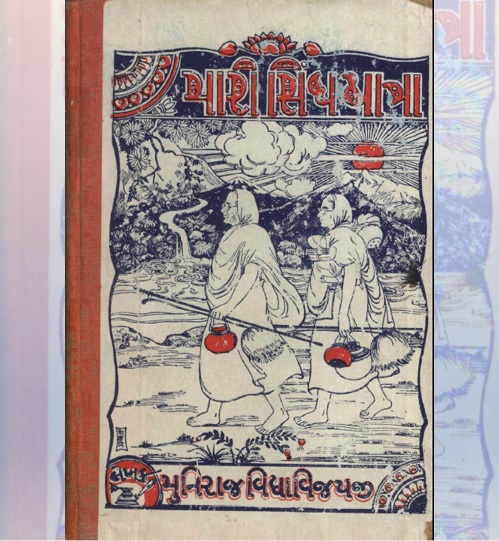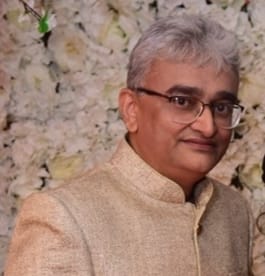
New Chhor has a good population with bright people, a school is also there, and inhibited by about three to four hundred families
[Editor’s Note: This is Part 11 (Dhoronaro and Mirpurkhas) of a series of articles based on a pre-partition book named “મારી સિંધ યાત્રા” (“منهنجي سنڌ جو سفر”) in Gujarati authored by Jain sadhu Shri Vidyavijayji, narrating his experiences of travel and stay in Karachi for about 2 and half a years between 1937 and 1939. It would be advisable to click on Introductory Article and read it for a better understanding of the series. – Nasir Aijaz, Editor Sindh Courier]
Vimal Shah, Mumbai
The transition from Dryland to Wetland
After crossing the borders of Marwad, sand mounds and deserts continue until Khokhrapar, Vasar Bah, Jalu-jo-Chunrd, Parche-ji-Veri, and New Chhor. The New Chhor village is very interesting. The railway station would consist of just one train compartment. This compartment accommodates the office, the family of the station master, and everything else.
New Chhor has a good population with bright people, a school is also there, and inhibited by about three hundred to four hundred families. There are about 60 houses of Maheshwari and 25 to 30 of Brahmins.
As we moved a bit ahead of this station, surprisingly we could see an entirely different environment. All the fields were flooded with water, green trees alongside the roads, grass, water everywhere, and due to that plenty of mosquitoes and clag. While walking you find everyone’s clothes full of insects and buzzing flies. Within just one mile the environment completely changed from dry to wet. The land that was without any traces of trees and water, was suddenly found flooded with them.
Surprisingly we could see an entirely different environment. All the fields were flooded with water, green trees alongside the roads, grass, and water everywhere
Glimpses of Gujarat
We were astonished to see glimpses of Gujarati (India) in the population here. How come glimpses of Gujarat in the Sindh region? On enquiring, we learnt that this village belongs to the Tharparkar district. The School and the Kanya Shala (Girl’s School) teach Gujarati up to the 5th standard, and Sindhi and Hindi too. The people maintain their accounts and other records in Gujarati. They use the Gujarati dialect, but it is mixed with Sindhi. During the entire journey, we could see cactus fences only over here.
Dhoronaro
In our journey from Marwad to Mirpurkhas, our halt at Dhoronaro should be considered a memorable one. After entering Sindh, we found the fields flooded with water all around, trees alongside the roads, sticky soil, humidity, and plenty of mosquitoes and clag. But we could once again see sand mounds at Dhoronaro. We came across sand and sand mounds for two miles continuously. Dhoronaro seemed like a good trade centre. It has a big station, bazaar, cotton gin industry and bungalows of the gin owners. But the Musalmans are very powerful here, and even murders are very common. The station masters and other staff are afraid of the Musalman population. We heard that they do not hesitate to sacrifice cows and goats even in the open.
Affluent Leaders of Karachi
We halted here for three days. A delegation of about twenty-five to thirty affluent members and other people, under the leadership of Sheth Chhotalal Khetshi, the president of the Managing Committee of the ‘Karachi Shwetambar Murtipujak Jain Sangh’, came to meet us. This was an opportunity to develop acquaintance with each other and deliver a lot of sermons.
Convention of Sadhus
We met a group of nine Sthanakvasi (name of a Jain sect) sadhu headed by Ghasilalji who were on their journey from Hyderabad to Marwad. Kheemchand Shah, Bhai Somchand, and Tribhovandas Shah – these three gentlemen were escorting them. The convention of about fifteen sadhus of two different Jain sects deliberating about Jainism in a non-vegetarian region like Sindh itself can be considered as a memorable event. Shri Ghasilalji was returning to Marwad after spending two ‘Chaturmas’ (monsoons) in Karachi. He appraised us about a lot of matters since he had a very good experience with the Jains and other populations of Karachi. We enjoyed our discussions on various subjects, and the next day they departed towards Marwad.
Roaring water would be flowing in the canal below, so by chance if you happen to see below, you get dizzy
Bridges over the Canals
There was a dangerous thing in this region and that was the bridges over the canals. We came across canals one after the other. The canals were full of water. There was no other way. So, we had to walk over the bridges only. There were no railings or fencings to the bridges. We had to walk on the wooden sleepers laid below the railway tracks. It is very dangerous for people who do not have the experience of walking on these sleepers. Roaring water would be flowing in the canal below, so by chance if you happen to see below, you get dizzy. In a few places, the canal stretches are very wide, so the bridges would be that long. The sleepers would be sticky, so you must walk slowly taking enough support. On top of that, there’s a danger of a train approaching from the front or the backside. The fear of the people who keep thinking ‘What if a train would come?’ is unimaginable. Such a person when gets down after crossing the bridge, feels like ‘Oh God! I got another life!’. The experienced and fearless people simply walk straight and cross the bridge. Do not ever see below while crossing such a bridge. You don’t get dizzy if you keep your eyes straight and walk. In other railway lines, they have fixed wooden or metal sheets between the tracks. But here it was like ‘Nobody’s business!’. Whenever we came across such bridges, everyone used to say, ‘What would have been ruined if the Jodhpur Sarkar had fixed sheets between these tracks!’
Mirpurkhas
Mirpurkhas is a district in Sindh. There’s a District Collector’s office here. The railway station is very big. It is also a trade Centre. There’s a railway control office too here. Some of the prominent people who treated us well are:
The controller of the Jodhpur Line, Hargovinddas Bhai, who is popularly known as ‘Raosaheb’ in the entire line, and amongst his friends. His headquarters is in Murpurkhas. An ideal gentleman with simple attire, simple life, thriving with devotion towards sadhus. Despite having no prior acquaintance, he used to send instructions to the station masters of every station and ensure adequate arrangements without any difficulty for our group. He is a Brahmin himself but has so much religious tolerance that even a pinch of religious differences has not affected him. He is in the habit of speaking slowly, speaking sweetly, and speaking less. His ideals are to be attentive for serving sadhus and guests with body, mind, and wealth. No one would be spared from loving his sweet nature and sincere humility. Not only he himself, but his entire family is cultured, modest, polite, and devoted.
The Mayor of Mirpurkhas and the Leader of the Arya Samaj, Guru Dinnamalji does tremendous work like a young man, despite being old
There was another controller Ramswarupji Punjabi along with him. They were like the pair of Ram and Lakshman. Ramswarupji was an expert in logic and reasoning. Even his entire family was very devoted.
We found the group of Ticket Collectors Jaswantrajji, Purshottamdasji, etc. in Mirpurkhas to be very devoted.
The Mayor of Mirpurkhas and the Leader of the Arya Samaj, Guru Dinnamalji does tremendous work like a young man, despite being old. This gentleman also publishes a periodical named ‘Mirpurkhas Gazette’ in the Sindhi language. He played a lead role in organizing two to three Vyakhyan (discourse) by us in Mirpurkhas. He uses his energies and intelligence against the people who abduct Hindu girls. And by doing that he protects the Hindu Community from a three-fold Musalman population. He is a well-respected Sindhi gentleman and an Aarya Samaji.
Malaria
Mirpurkhas means an ocean of Malaria. There’s a lot of humidity due to canals and flooded water all over the place. And therefore, there’s a huge nuisance of mosquitoes resulting in widespread malaria. It can be said that our entire group got traces of Malaria to some extent from here.
Mirpurkhas means an ocean of Malaria. There’s a lot of humidity due to canals and flooded water all over the place
Even those who did not get fever also must have at least carried a few malarial parasites. This author could not resist and went down with more than 105 degrees fever. I was fortunate that a doctor treated me with an injection of twenty grains of Quinine and I recovered within two days. As soon as the temperature came down a bit, we departed from Mirpur on 7th April 1937.
Our journey until here was completed by walking along the railway tracks. Therefore, we did not have any means of truly knowing the Sindh region, other than the railway stations. The stations were mostly barren and uninhabited, so there was no opportunity to interact with anyone other than a few specific people. From here on, we had to dive deep into Sindh. (Continues – Read the 12th Part on Sunday May 21, 2023)
Click here for Part-I, Part-II, Part-III, Part-IV, Part-V , Part-VI , Part-VII , Part-VIII , Part-IX, Part-X
________________
About the contributor of the series of Articles based on the book
 Vimal Shah is a follower of Jainism by birth and is based in Mumbai, India. He is a Computer Engineer and holds a Diploma in Jainology from Mumbai University. He has immense interest in reading, writing, studying, and teaching Jain Philosophical subjects. He conducts classroom as well as on-line sessions on Jain Philosophical courses. He has created several power point presentations with animation which he uses while teaching and has participated in several Jain Community events to present and explain the relevant subjects to the visiting audience. He has significantly contributed to the translation, reviewing, and editing of the set of books ‘Compendium of Jainism’ of JAINA, USA from English to Gujarati – an initiative of the JAINA India Foundation. He is also associated with a Project for the translation of Jain Aagams (Scriptures) from Gujarati to English and continues to study various subjects and remains a student of Jain Philosophy. He has a special interest in the history and preservation of the Jain Heritage in Pakistan, and is associated with the Jain Heritage Foundation, New Delhi.
Vimal Shah is a follower of Jainism by birth and is based in Mumbai, India. He is a Computer Engineer and holds a Diploma in Jainology from Mumbai University. He has immense interest in reading, writing, studying, and teaching Jain Philosophical subjects. He conducts classroom as well as on-line sessions on Jain Philosophical courses. He has created several power point presentations with animation which he uses while teaching and has participated in several Jain Community events to present and explain the relevant subjects to the visiting audience. He has significantly contributed to the translation, reviewing, and editing of the set of books ‘Compendium of Jainism’ of JAINA, USA from English to Gujarati – an initiative of the JAINA India Foundation. He is also associated with a Project for the translation of Jain Aagams (Scriptures) from Gujarati to English and continues to study various subjects and remains a student of Jain Philosophy. He has a special interest in the history and preservation of the Jain Heritage in Pakistan, and is associated with the Jain Heritage Foundation, New Delhi.